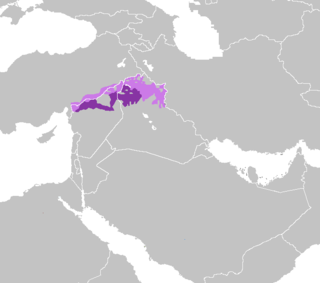North Mesopotamian Arabic
Contributors to Wikimedia projects
 Article Images
Article Images
North Mesopotamian Arabic, also known as Moslawi (meaning 'of Mosul'), Mardelli (meaning 'of Mardin'), Mesopotamian Qeltu Arabic, or Syro-Mesopotamian Arabic, is one of the two main varieties of Mesopotamian Arabic, together with Gilit Mesopotamian Arabic.[1]
| North Mesopotamian Arabic | |
|---|---|
| Moslawi Arabic Mardelli Arabic Qeltu Mesopotamian Arabic Syro-Mesopotamian Arabic | |
| لهجة موصلية | |
| Native to | Iraq, Syria, Turkey[1] |
| Speakers | 10 million (2019–2023)[1] |
| |
| Dialects | |
| Arabic alphabet | |
| Language codes | |
| ISO 639-3 | ayp |
| Glottolog | nort3142 |
| ELP | North Mesopotamian Arabic |
 | |
Relationship to Gilit Mesopotamian
Mesopotamian Arabic has two major varieties: Gelet Mesopotamian Arabic and Qeltu Mesopotamian Arabic. Their names derive from the form of the word for "I said" in each variety.[2] Gelet Arabic is a Bedouin variety spoken by Muslims (both sedentary and non-sedentary) in central and southern Iraq and by nomads in the rest of Iraq. Qeltu Arabic is an urban dialect spoken by Non-Muslims of central and southern Iraq (including Baghdad) and by the sedentary population (both Muslims and Non-Muslims) of the rest of the country.[3] Non-Muslims include Christians, Yazidis, and Jews, until most Iraqi Jews left Iraq in the 1940s–1950s.[4][5] Geographically, the gelet–qeltu classification roughly corresponds to respectively Upper Mesopotamia and Lower Mesopotamia.[6] The isogloss is between the rivers Tigris and Euphrates, around Fallujah and Samarra.[6]
During the Siege of Baghdad (1258), the Mongols killed all Muslims.[7] However, sedentary Christians and Jews were spared and northern Iraq was untouched.[7] In southern Iraq, sedentary Muslims were gradually replaced by Bedouins from the countryside.[7] This explains the current dialect distribution: in the south, everyone speaks Bedouin varieties close to Gulf Arabic (continuation of the Bedouin dialects of the Arabian Peninsula),[7][8] with the exception of urban Non-Muslims who continue to speak pre-1258 qeltu dialects while in the north the original qeltu dialect is still spoken by all, Muslims and Non-Muslims alike.[7]
| s-stem | Bedouin/gelet | Sedentary/qeltu |
|---|---|---|
| 1st sg. | ḏạrab-t | fataḥ-tu |
| 2nd m. sg. | ḏạrab-t | fataḥ-t |
| 2nd f. sg. | tišṛab-īn | tǝšrab-īn |
| 2nd pl. | tišṛab-ūn | tǝšrab-ūn |
| 3rd pl. | yišṛab-ūn | yǝšrab-ūn |
Qeltu dialects include:[6]
- Qeltu
- Anatolian Qeltu
- Tigris Qeltu
- Euphrates Qeltu
- Khawetna (Syria, Iraq, Turkey)
- Deir ez-Zor
- Anah and Abu Kamal
- Hit, Iraq
Baghdadi Arabic is Iraq's de facto national vernacular, as about half of population speaks it as a mother tongue, and most other Iraqis understand it. It is spreading to northern cities as well.[10] Other Arabic speakers cannot easily understand Moslawi and Baghdadi.[10]
The peripheral Anatolian Arabic varieties in Siirt, Muş and Batman are quite divergent.[citation needed]
Cypriot Arabic shares a number of common features with North Mesopotamian Arabic, and one of its pre-Cypriot medieval antecedents has been deduced as belonging to this dialect area.[11][12] However, its current form is a hybrid of different varieties and languages, including Levantine Arabic and Greek.[11]
- ^ a b c North Mesopotamian Arabic at Ethnologue (27th ed., 2024)
- ^ Mitchell, T. F. (1990). Pronouncing Arabic, Volume 2. Clarendon Press. p. 37. ISBN 0-19-823989-0.
- ^ Jasim, Maha Ibrahim (2022-12-15). "The Linguistic Heritage of the Maṣlāwī Dialect in Iraq". CREID Working Paper 18. doi:10.19088/creid.2022.015.
- ^ Holes, Clive, ed. (2018). Arabic Historical Dialectology: Linguistic and Sociolinguistic Approaches. Oxford University Press. p. 337. ISBN 978-0-19-870137-8. OCLC 1059441655.
- ^ Procházka, Stephan (2018). "3.2. The Arabic dialects of northern Iraq". In Haig, Geoffrey; Khan, Geoffrey (eds.). The Languages and Linguistics of Western Asia. De Gruyter. pp. 243–266. doi:10.1515/9783110421682-008. ISBN 978-3-11-042168-2. S2CID 134361362.
- ^ a b c Ahmed, Abdulkareem Yaseen (2018). Phonological variation and change in Mesopotamia: a study of accent levelling in the Arabic dialect of Mosul (PhD thesis). Newcastle University.
- ^ a b c d e Holes, Clive (2006). Ammon, Ulrich; Dittmar, Norbert; Mattheier, Klaus J.; Trudgill, Peter (eds.). "The Arabian Peninsula and Iraq/Die arabische Halbinsel und der Irak". Sociolinguistics / Soziolinguistik, Part 3. Berlin/New York: Walter de Gruyter: 1937. doi:10.1515/9783110184181.3.9.1930. ISBN 978-3-11-019987-1.
- ^ Al‐Wer, Enam; Jong, Rudolf (2017). "Dialects of Arabic". In Boberg, Charles; Nerbonne, John; Watt, Dominic (eds.). The Handbook of Dialectology. Wiley. p. 529. doi:10.1002/9781118827628.ch32. ISBN 978-1-118-82755-0. OCLC 989950951.
- ^ Prochazka, Stephan (2018). "The Northern Fertile Crescent". In Holes, Clive (ed.). Arabic Historical Dialectology: Linguistic and Sociolinguistic Approaches. Oxford University Press. p. 266. doi:10.1093/oso/9780198701378.003.0009. ISBN 978-0-19-870137-8. OCLC 1059441655.
- ^ a b Collin, Richard Oliver (2009). "Words of War: The Iraqi Tower of Babel". International Studies Perspectives. 10 (3): 245–264. doi:10.1111/j.1528-3585.2009.00375.x.
- ^ a b Versteegh, Kees (2001). The Arabic Language. Edinburgh University Press. p. 212. ISBN 0-7486-1436-2.
- ^ Owens, Jonathan (2006). A Linguistic History of Arabic. Oxford University Press. p. 274. ISBN 0-19-929082-2.
- ^ del Rio Sanchez, Francisco (2013). "Influences of Aramaic on dialectal Arabic". In Sala, Juan Pedro Monferrer; Watson, Wilfred G. E. (eds.). Archaism and Innovation in the Semitic Languages: Selected Papers. Oriens Academic. ISBN 978-84-695-7829-2.
- ^ Smart, J. R. (2013). Tradition and Modernity in Arabic Language And Literature. Routledge. doi:10.4324/9781315026503. ISBN 978-1-136-78805-5.
- ^ R. J. al-Mawsely, al-Athar, al-Aramiyyah fi lughat al-Mawsil al-amiyyah (Lexicon: Aramaic in the popular language of Mosul): Baghdad 1963
- ^ Afsaruddin, Asma; Zahniser, A. H. Mathias, eds. (1997). Humanism, Culture, and Language in the Near East: Studies in Honor of Georg Krotkoff. Penn State University Press. doi:10.5325/j.ctv1w36pkt. ISBN 978-1-57506-020-0. JSTOR 10.5325/j.ctv1w36pkt.